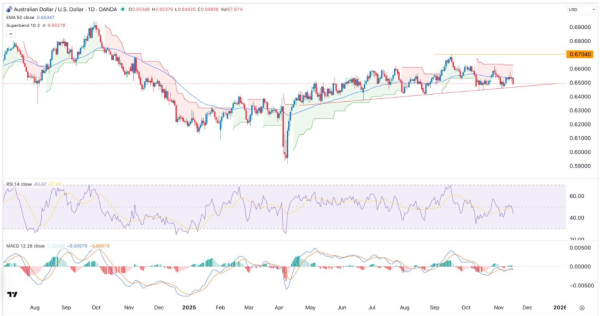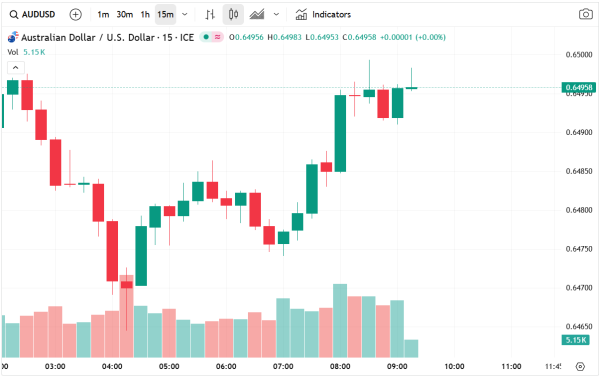The AUD/USD exchange rate has come under renewed downward pressure following the recent publication of the Reserve Bank of Australia (RBA) minutes. Investors have responded cautiously to the report, which emphasized ongoing concerns about inflation and economic capacity, reinforcing a risk-off sentiment in the market.
As a result, the AUD/USD pair dropped to 0.6490, retreating sharply from the year-to-date high of 0.6700. LFtrade experts deliver a detailed and insightful analysis of the subject in their latest piece.
RBA and Fed Interest Rate Minutes
The AUD/USD currency pair reacted modestly to the latest RBA minutes from the most recent monetary policy meeting. In that session, the RBA surprised markets by leaving official cash rates unchanged at 3.6%, following three previous rate cuts earlier this year.
The minutes revealed that RBA officials remain concerned about elevated inflation, which has persisted over the past several months. Bureau of Labor Statistics (BLS) data highlighted that inflation remained above 3% in the fourth quarter, signaling sustained price pressures in the economy.
Officials indicated that further rate reductions could exacerbate inflationary pressures, potentially overheating the domestic economy. The labor market was noted as a key factor, with the unemployment rate holding steady at 4.3% and employment increasing to 14.68 million, reflecting a tight labor market.
Looking ahead, the AUD/USD pair is expected to respond to the upcoming Federal Reserve minutes, scheduled for release on Wednesday. These minutes will provide further guidance on US monetary policy, including interest rate projections and the Fed’s economic outlook.
Additionally, the pair will face volatility during the release of the US nonfarm payroll report on Thursday, which will include employment growth data but exclude the unemployment rate. Traders should be prepared for heightened market reactions, as both US and Australian macroeconomic reports provide directional cues for FX positioning.
AUD/USD Technical Analysis
From a technical perspective, the daily chart of AUD/USD highlights a clear bearish bias. The pair has declined from the year-to-date high of 0.6700 to the current 0.6490, reflecting strong selling pressure.
The 50-day Exponential Moving Average (EMA) now acts as resistance, with the pair trading below this key level, indicating sustained downtrend momentum. Similarly, the Supertrend indicator has turned negative, confirming that bears remain in control.

Momentum indicators further reinforce the bearish outlook. The Relative Strength Index (RSI) is declining, suggesting weakening buying interest, while the MACD continues to trend downward, signaling negative momentum.
Price action has also formed a head-and-shoulders pattern, a classic reversal signal, which supports expectations of further downside movement. The next significant support level sits at 0.6400, representing a potential target for sellers.
Conversely, a breach above the resistance level at 0.6600 would challenge the bearish structure and may trigger a technical rebound, but the current trend alignment favors continued downward pressure.
AUD/USD Forecast: What Traders Should Expect Next
Looking ahead, the AUD/USD forecast remains skewed to the downside as market volatility increases. Analysts suggest that unless Australian economic data surprises to the upside, the pair is likely to continue its bearish trend toward the 0.6400 support level. Traders should also watch for US macroeconomic releases, including inflation data and interest rate guidance, which could amplify short-term swings.

Market Sentiment and Risk Factors
The market sentiment has shifted towards risk aversion following the RBA minutes, with traders factoring in macro uncertainties and monetary policy divergence between Australia and the United States.
Investors are closely monitoring interest rate differentials, as the Federal Reserve is expected to maintain a hawkish stance relative to the RBA’s cautious approach. This divergence tends to strengthen the US dollar against the Australian dollar, contributing to the bearish tone in the AUD/USD pair.
Additional risk factors include geopolitical tensions, commodity price volatility, and global economic growth concerns, all of which can influence FX flows and exacerbate AUD/USD declines.
Conclusion: Bearish Outlook Remains Strong
In summary, the AUD/USD Forex signal remains extremely bearish in the short term. The combination of RBA caution, high inflation concerns, and strong labor market data has created an environment where further downside is likely.
Technical indicators, including the 50-day EMA, Supertrend, RSI, MACD, and the head-and-shoulders pattern, all point to continued selling pressure. Key support is seen at 0.6400, while resistance at 0.6600 must be breached to invalidate the bearish outlook.
Traders should monitor the upcoming US Fed minutes and nonfarm payroll data, as these releases will provide critical market direction cues. Overall, the current risk-off sentiment supports the view that AUD/USD could test lower levels in the near term, offering potential opportunities for short-term traders following a bearish strategy.










